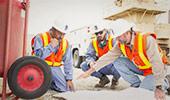If you're a public works, permitting or planning official working on a city planning and development project that involves work around natural gas pipelines, the following safety information will help make sure your project goes smoothly.
City Planning and Development Projects with SoCalGas®
We encourage you to review the information provided by the Pipelines and Informed Planning Alliance* (PIPA) because the decisions you make can impact the safety of the community surrounding the pipeline. You can always contact us and we can guide you through safe practices when building around our major natural gas pipelines.
Planning Resources
- Land Development in Close Proximity to Transmission Pipelines Brochure* (PDF)
A brochure for local governments regarding recommended practices for planning, permitting and development near underground transmission pipelines. - PIPA Evaluation Worksheet for Local Governments* (PDF)
Worksheet for local government planning and permitting officials. Designed for use when permitting development near existing transmission pipelines. - PIPA Summary Report for County Officials* (PDF) Summary of recommendations and best practices from PIPA’s November 2010 report for permitting, planning and development near transmission pipelines. Prepared by the National Association of Counties (NACo).
- Land Use and Development Checklist* (PDF)
Checklist for planning, design, communication, permitting and site plan review for projects near existing transmission pipelines. - Pipeline Risk and its Application to Local Development Decisions* (PDF)
Report developed by the U.S. Department of Transportation Pipeline and Hazardous Materials Safety Administration to help local governments and developers understand pipeline risks, and to provide best practices for permitting developments near existing hazardous liquids and natural gas transmission pipelines. - Pipelines and Informed Planning Alliance Report & Recommendations* (PDF)
Final report and recommended practices to help in making decisions about what, where and how to build safely near transmission pipelines.
High Consequence Area (HCA) Designation
It’s important to know if your city is designated as a High Consequence Area (HCA) or Non-High Consequence (Non-HCA) Area.* Pipeline safety regulations use the concept of HCAs to identify specific locations where a natural gas leak could have the most significant adverse consequences. Your city's designation is based on population and pipeline locations.
Additional Resources
- The Pipeline Association for Public Awareness’ (PAPA) Newsletter* provides articles to educate public officials about pipeline safety and awareness.
- Pipelines Nearby*, is a web application that locates our transmission lines in relation to the address you specify.
- Pipeline Safety Trust* provides reference resources for local government officials.
- Visit the National Emergency Number Association (NENA)* for emergency communications issues. The association is focused on 911 policy, technology, operations and education issues.

Contact 811 Before You Dig!
Stay safe and avoid costly repairs. Contact 811 before you dig at least two business days in advance, excluding the date of notification, to have utility-owned lines marked. Learn More
Español | 한국어. | Tiếng Việt. | 中文. | Tagalog.

How to Recognize a Natural Gas Leak
Learn how your senses of sight hearing and smell can alert you to a natural gas leak.

Emergency Response Planning
Learn how we work with public officials during an emergency to ensure public safety.
